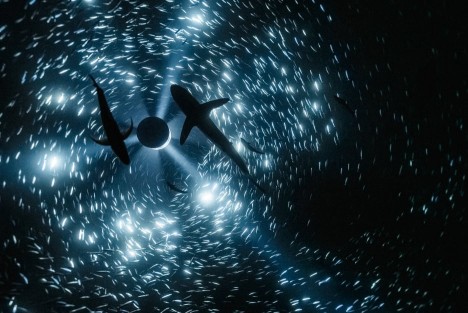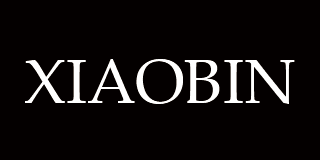Review
A World of Water
Maja and Reuben Fowkes feel the urgency of the curator’s question: can the seas survive us?

Julian Charrière, Midnight Zone, 2024
A circling standpipe is the only work in ‘A World of Water’ on ground level, positioned by the stairwell that leads to the lower galleries of the Sainsbury Centre where, fittingly, the exhibition continues, submerged below the surface. Triggering associations with our unmindful dependence on water and planetary processes of hydrological circulation, Spiral Fosset, 2023, is one of a constellation of works by Amsterdam-based artist collective de Onkruidenier, an intertidal community of ‘salt lovers’ dedicated to rediscovering their evolutionary bonds with the ocean. The darker side of marine discovery is represented nearby by Berlin-based Julian Charrière’s Midnight Zone, 2024, which relies on the beam of a sunken lighthouse lens to illuminate the liveliness of aqueous ecosystems flourishing out of reach of sunlight, but now endangered by the deep-sea mining of rare minerals. Also prominent in the first room is a vertiginous chair, its legs drastically extended with delicately balanced wooden blocks to elevate the sitter above the highwater mark that scientists predict for 2100. Designed by Boris Maas, with another edition installed in the office of the Dutch Minister of the Environment, The Urge to Sit Dry, 2018, demonstrates the acute challenge posed by climate breakdown for communities living below the waterline.
Addressing the current state of marine worlds ineluctably brings to the fore the multiple and interlocking crises of industrial overfishing, insidious chemical and nuclear pollution, the amassing of plastic detritus, as well as ocean acidification, oxygen loss and habitat destruction as a result of rapidly warming water temperatures. Recognition of the vast scale of ‘the human impact on interconnected seas’ informs the question guiding the venue’s programme this season: ‘Can the seas survive us?’
The exhibition responds not with straightforward answers, but undulates like a coral reef across a sprawling seascape of driftwood paintings, sculpted ocean plastics and repurposed turbine blades, as well as sound and video pieces, historical canvases, nautical archives, cartographic imaginings and contemporary commissions. Such a capacious approach engenders further reflections on how to rethink our connection to the sea, where to look for more harmonious models of human–marine interaction and what connects coast dwellers around the world.
There is a particular resonance in staging the exhibition in Norfolk, where rising sea levels, receding shorelines and coastal erosion cast a long shadow over the future of exposed communities. The innocuous title Bungalow on Beach and Cliffs at Covehithe, 2019, accentuates the drama of a small-format painting by Julian Perry, which depicts the aftermath of a cliff collapse with someone’s seaview home sliding remorselessly towards the sea. In Coastal Squeeze, 2023, Norfolk artist Jayne Ivimey adds dark bands to a faint landscape to visualise the strain on coastal environments caught between human intervention and natural forces. As rising seas pressure shorelands, the rigid barriers erected along beaches to prevent erosion squeeze the coastline ‘like a concrete corset’, compelling us to rethink conservation and envisage nature reshaping the coast. Andrew Watkinson, the former director of the University of East Anglia’s centre for climate change research, is represented in the exhibition with a work titled A Discussion About Coastal Erosion in Norfolk Based on Research from the Tyndall Centre, 2024. By superimposing bold phrases such as ‘I worry about it every day’ or ‘we can’t just let it fall into the sea’ onto dense scholarly articles, his piece demonstrates how the emotional urgency of climate breakdown cuts across the dispassionate methodologies of scientific rationality.
Archival materials and historical perspectives are drawn upon to shed light on the enduring maritime connections between East Anglia and the Low Countries, dating back to an influx of Dutch protestant refugees in the Elizabethan era, who brought their Netherlandish expertise to the draining of the Fens. Parallels are suggested in the influence of the Dutch Golden Age on the landscape painters of the Norwich School in providing a model for articulating a finely balanced relationship with the seas. Among the historical canvases is Hendrick van Anthonissen’s View of Scheveningen Sands with Stranded Sperm Whale, 1641, which depicts – as restoration of the painting revealed – a beached whale on the Dutch coast. It is encountered today as a reminder that we are not the only mammals to traverse the oceans, but also functions as a metaphor for collective feelings of defencelessness at being left stranded by global climate inaction. The video work Brexit Herring, 2023, by Amsterdam-based Anastasia Eggers explores the contradiction between ‘taking back control’ and the cross-border lives of herring that spawn near the English coast before migrating to European waters; it is accompanied by a flag that features a circle of herring instead of gold stars, with one fish swimming demonstrably away from the shoal.
Floating between local, regional and planetary scales, ‘A World of Water’ makes a transhemispheric connection to indigenous communities that share the sense of climate foreboding of inhabitants of coastal lowlands everywhere. Philippines-based artist Cian Dayrit turns the spotlight on hydraulic infrastructures that have reconfigured waterways in the service of extractivism in a multimedia work titled Dam Nation, 2023, depicting a cosmic landscape of pyramidical peaks and meandering arterial flows cut off by the blade of Anthropocene intervention. Shifting the focus to the more-than-human inhabitants of aquatic realms, Dutch artist Koen Taselaar’s tapestry Radical Furniture for Radical Times II, 2024, shows octopuses turning flooded settlements into tentacular playgrounds. The fact that these are not ruined or abandoned buildings from another era, but functional homes with modernist touches that appear to have been suddenly surrendered to the sea, underlines the shock proximity of climate disaster.
‘A World of Water’ articulates from a particular bioregional position an understanding of the interconnectedness of the marine world and our existential dependence on its riches and flows, as well as the threat posed to ocean life by rampant pollution, extractivism and climate transformation. Yet the planetary question ‘can the sea survive us?’ has further ramifications here, where an older refrain of whether we can survive the sea is coming back with a vengeance as sea levels rise.
‘Can the Seas Survive Us? A World of Water’, Sainsbury Centre, Norwich, 15 March to 3 August 2025
Maja and Reuben Fowkes are co-directors of the Translocal Institute and founders of the Post-socialist Art Centre, UCL.
First published in Art Monthly 486: May 2025.









